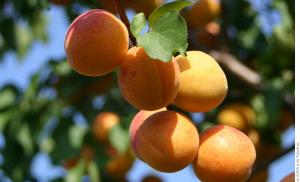Classification, types and types of climatic precipitation. Climate and types of precipitation
What is water vapor? What properties does it have?
Water vapor - gaseous state water. It has no color, taste or smell. Found in the troposphere. Formed by water molecules during its evaporation. Water vapor, when cooled, turns into water droplets.
What seasons of the year does it rain in your area? What are the snowfalls?
Rains fall in summer, autumn, spring. Snowfalls - winter, late autumn, early spring.
Compare the average annual rainfall in Algeria and Vladivostok using Figure 119. Is rainfall distributed equally over the months?
The annual precipitation in Algeria and Vladivostok is almost the same - 712 and 685 mm, respectively. However, their distribution during the year is different. In Algeria, the maximum precipitation occurs at the end of autumn and winter. Minimum - for summer months. In Vladivostok, most of the precipitation falls in summer and early autumn, with a minimum in winter.
Look at the picture and talk about the alternation of belts with different annual rainfall.
In the distribution of precipitation in general, there are changes in the direction from the equator to the poles. They fall in a wide band along the equator the largest number- over 2000 mm per year. In tropical latitudes, there is very little precipitation - an average of 250-300 mm, and in temperate latitudes there are more of them again. With further approach to the poles, the amount of precipitation again decreases to 250 mm per year or less.
Questions and tasks
1. How is precipitation formed?
Precipitation is water that falls to the ground from clouds (rain, snow, hail) or directly from the air (dew, hoarfrost, frost). Clouds are made up of tiny water droplets and ice crystals. They are so small that they are held by air currents and do not fall to the ground. But droplets and snowflakes can merge with each other. Then they increase in size, become heavy and fall to the ground in the form precipitation.
2. Name the types of precipitation.
Precipitation is liquid (rain), solid (snow, hail, grains) and mixed (snow with rain)
3. Why does the collision of warm and cold air lead to precipitation?
When faced with cold air warm air, displaced by heavy cold, rises up, begins to cool. Water vapor in warm air condenses. This leads to the formation of clouds and precipitation.
4. Why in cloudy weather Doesn't it always rain?
Precipitation occurs only when the air is saturated with moisture.
5. How can one explain that there is a lot of precipitation near the equator, and very little in the regions of the poles?
A large amount of precipitation falls near the equator, because due to high temperatures a large amount of moisture evaporates. The air is quickly saturated and precipitation falls. At the poles low temperatures air prevents evaporation.
6. What is the annual rainfall in your area?
In the European part of Russia, about 500 mm falls on average per year.
Surely, each of us has ever watched the rain through the window. But have we thought about what kind of processes occur in rain clouds? What types of precipitation can receive? That is what got me interested. I opened my favorite home encyclopedia and stopped at the section with the heading "Types of Precipitation". What was written there, I'm going to tell.
What are the precipitation
Any precipitation falls due to the enlargement of elements in the clouds (for example, water droplets or ice crystals). Having increased to a size at which they can no longer be in suspension, the drops fall down. Such a process is called "coalescence"(which means "fusion"). And the further growth of drops occurs already in view of their merging in the process of falling.
Atmospheric precipitation often takes quite different types. But in science there are only three main groups:
- massive precipitation. These are the precipitations that usually fall during very long period with medium intensity. Such rain covers the largest area itself and falls from special nimbostratus clouds that cover the sky, not letting in light;
- rainfall. They are the most intense, but short-lived. Originate from cumulonimbus clouds;
- drizzling rain. They, in turn, are made up of small droplets - drizzle. This kind of rain can last a very long time. long time. Drizzling precipitation falls from stratus (including stratocumulus) clouds.

In addition, precipitation is divided according to their consistency. This is what will be discussed now.
Other types of precipitation
Additionally, the following types of precipitation are distinguished:
- liquid precipitation. Basic. It was about them that was mentioned above (overlapping, torrential and drizzling types of rain);
- solid precipitation. But they fall out, as you know, at a negative temperature. Such precipitation takes on various shapes (snow of the most different forms, hail and so on...);
- mixed precipitation. Here the name speaks for itself. An excellent example is a cold freezing rain.

These are the different types of precipitation. And now it is worth making some interesting remarks about their loss.
The shape and size of snowflakes are determined by the temperature in the atmosphere and the strength of the wind. The purest and driest snow on the surface is capable of reflecting about 90% light from sun rays.

More intense and larger (in the form of drops) rains occur on small areas. There is a relationship between the size of territories and the amount of precipitation.
The snow cover is able to independently emit thermal energy , which, nevertheless, quickly escapes into the atmosphere.

Clouds with clouds have huge weight. More than 100 thousand km³ of water.
Precipitation Atmospheric precipitation - water in a drop liquid (rain, drizzle) and solid (snow, cereal, hail) state, falling out of clouds or deposited directly from the air on the surface of the Earth and objects (dew, drizzle, hoarfrost, ice) as a result of condensation of water vapor, in the air.
Atmospheric precipitation is also the amount of water that has fallen in certain place for a certain period of time (usually measured by the thickness of the layer of precipitated water in mm). The amount of precipitation depends on air temperature, atmospheric circulation, topography, sea currents.
Distinguish overhead precipitation, associated mainly with warm fronts, and showers associated with cold fronts. Precipitation from the air: dew, frost, frost, ice.
Precipitation is measured by the thickness of the layer of fallen water in millimeters. On average, approx. 1000 mm of precipitation per year: from 2500 mm in wet equatorial forests up to 10 mm in deserts and 250 mm in high latitudes. Precipitation is measured by rain gauges, rain gauges, pluviographs on meteorological stations, and for large areas- with the help of radar.
Precipitation classification
Precipitation falling on the earth's surface
Heavy rainfall- are characterized by monotony of precipitation without significant fluctuations in intensity. Start and stop gradually. The duration of continuous precipitation is usually several hours (and sometimes 1-2 days), but in some cases, light precipitation can last half an hour or an hour. They usually fall out of stratified rain or high stratus clouds; at the same time, in most cases, the cloudiness is continuous (10 points) and only occasionally significant (7-9 points, usually at the beginning or end of the precipitation period). Sometimes weak short-term (half an hour to an hour) general precipitation is observed from stratus, stratocumulus, altocumulus clouds, while the number of clouds is 7-10 points. In frosty weather (air temperature below -10 ... -15 °), light snow can fall from a cloudy sky.
Rain- liquid precipitation in the form of droplets with a diameter of 0.5 to 5 mm. Separate raindrops leave a trace in the form of a diverging circle on the surface of the water, and in the form of a wet spot on the surface of dry objects.
supercooled rain- liquid precipitation in the form of drops with a diameter of 0.5 to 5 mm, falling out at negative air temperatures (most often 0 ... -10 °, sometimes up to -15 °) - falling on objects, the drops freeze and ice forms.
freezing rain- solid precipitation falling at negative air temperature (most often 0 ... -10 °, sometimes up to -15 °) in the form of solid transparent ice balls with a diameter of 1-3 mm. There is unfrozen water inside the balls - falling on objects, the balls break into shells, water flows out and ice forms.
Snow- solid precipitation falling (most often at negative air temperatures) in the form of snow crystals (snowflakes) or flakes. With light snow, horizontal visibility (if there are no other phenomena - haze, fog, etc.) is 4-10 km, with moderate 1-3 km, with heavy snow - less than 1000 m (at the same time, snowfall intensifies gradually, so that visibility values of 1-2 km or less are observed no earlier than one hour after the start of snowfall). In frosty weather (air temperature below -10 ... -15 °), light snow can fall from a cloudy sky. Separately, the phenomenon of wet snow is noted - mixed precipitation that falls at a positive air temperature in the form of flakes of melting snow.
Rain with snow- mixed precipitation falling (most often at positive air temperature) in the form of a mixture of drops and snowflakes. If rain with snow falls at a negative air temperature, particles of precipitation freeze on objects and ice forms.
Drizzling precipitation- characterized by low intensity, monotony of precipitation without changing the intensity; start and stop gradually. The duration of continuous precipitation is usually several hours (and sometimes 1-2 days). Fall out of stratus clouds or fog; at the same time, in most cases, the cloudiness is continuous (10 points) and only occasionally significant (7-9 points, usually at the beginning or end of the precipitation period). Often accompanied by a deterioration in visibility (haze, fog).
drizzle- liquid precipitation in the form of very small drops (less than 0.5 mm in diameter), as if floating in the air. A dry surface gets wet slowly and evenly. Settling on the surface of the water does not form diverging circles on it.
supercooled drizzle- liquid precipitation in the form of very small drops (less than 0.5 mm in diameter), as if floating in the air, falling out at negative air temperature (most often 0 ... -10 °, sometimes up to -15 °) - settling on objects, drops freeze and form ice.
snow grains- solid precipitation in the form of small opaque white particles (sticks, grains, grains) with a diameter of less than 2 mm, falling out at negative air temperatures.
heavy rainfall- characterized by the suddenness of the beginning and end of the fallout, abrupt change intensity. The duration of continuous fallout is usually from several minutes to 1-2 hours (sometimes several hours, in the tropics - up to 1-2 days). Often accompanied by a thunderstorm and a short-term increase in wind (squall). They fall out of cumulonimbus clouds, while the amount of clouds can be both significant (7-10 points) and small (4-6 points, and in some cases even 2-3 points). The main sign of rain showers is not their high intensity (rain showers can be weak), but the very fact of falling out of convective (most often cumulonimbus) clouds, which determines the fluctuations in precipitation intensity. AT hot weather weak heavy rain may fall from powerful cumulus, and sometimes (very light showers) even from medium cumulus.
torrential rain- torrential rain.
shower snow- heavy snow. It is characterized by sharp fluctuations in horizontal visibility from 6-10 km to 2-4 km (and sometimes up to 500-1000 m, in some cases even 100-200 m) over a period of time from several minutes to half an hour (snow "charges").
Heavy rain with snow- Mixed precipitation of a shower character, falling out (most often at positive air temperature) in the form of a mixture of drops and snowflakes. If heavy rain with snow falls at a negative air temperature, particles of precipitation freeze on objects and ice forms.
snow grits- solid precipitation of a shower character, falling out at an air temperature of about zero ° and having the form of opaque white grains with a diameter of 2-5 mm; grains are fragile, easily crushed by fingers. It often falls before or at the same time as heavy snow.
ice grits- solid precipitation of a shower character, falling at an air temperature of -5 to +10 ° in the form of transparent (or translucent) ice grains with a diameter of 1-3 mm; in the center of the grains is an opaque core. The grains are quite hard (they are crushed with fingers with some effort), and when they fall on a hard surface, they bounce off. In some cases, the grains can be covered with a water film (or fall out together with water droplets), and if the air temperature is below zero °, then falling on objects, the grains freeze and ice forms.
hail- solid precipitation falling in the warm season (at air temperatures above + 10 °) in the form of ice pieces various shapes and sizes: usually the diameter of hailstones is 2-5 mm, but in some cases individual hailstones reach the size of a pigeon and even chicken egg(then hail causes significant damage to vegetation, car surfaces, breaks window panes etc.). The duration of the hail is usually small - from 1-2 to 10-20 minutes. In most cases, hail is accompanied by heavy rain and thunderstorms.
Unclassified precipitation
ice needles- solid precipitation in the form of tiny ice crystals floating in the air, formed in frosty weather (air temperature below -10 ... -15 °). During the day they sparkle in the light of the rays of the sun, at night - in the rays of the moon or in the light of lanterns. Quite often, ice needles form beautiful luminous "pillars" at night, going from the lanterns up into the sky. They are observed most often in clear or slightly cloudy skies, sometimes they fall out of cirrostratus or cirrus clouds. ice needles
Precipitation formed on the surface of the earth and on the metah
Dew- water droplets formed on the surface of the earth, plants, objects, roofs of buildings and cars as a result of the condensation of water vapor contained in the air at positive air and soil temperatures, cloudy skies and light winds. Most often observed at night and early morning hours, may be accompanied by haze or fog. Abundant dew can cause measurable precipitation (up to 0.5 mm per night), runoff to the ground from rooftops.
Frost- a white crystalline precipitate that forms on the surface of the earth, grass, objects, roofs of buildings and cars, snow cover as a result of sublimation of water vapor contained in the air at negative soil temperatures, cloudy skies and light winds. It is observed in the evening, night and morning hours, may be accompanied by haze or fog. In fact, this is an analogue of dew, formed at a negative temperature. On the branches of trees, wires, frost is deposited weakly (unlike frost) - on the wire of an icing machine (diameter 5 mm), the thickness of frost deposition does not exceed 3 mm.
Crystal frost- a white crystalline precipitate, consisting of small fine-structured shiny particles of ice, formed as a result of sublimation of water vapor contained in the air on tree branches and wires in the form of fluffy garlands (easily crumbling when shaken). It is observed in slightly cloudy (clear, or clouds of the upper and middle tiers, or broken-stratified) frosty weather (air temperature is below -10 ... -15 °), with haze or fog (and sometimes without them) with light wind or calm. Hoarfrost usually occurs within a few hours at night, during the day it gradually crumbles under the influence of sunlight, but in cloudy weather and in shade it can persist throughout the day. On the surface of objects, roofs of buildings and cars, frost is deposited very weakly (unlike hoarfrost). However, frost is often accompanied by frost.
grainy frost- white loose snow-like sediment formed as a result of settling of small droplets of supercooled fog on tree branches and wires in cloudy foggy weather (at any time of the day) at air temperatures from zero to −10 ° and moderate or strong wind. When the fog droplets become larger, it can turn into ice, and when the air temperature drops, combined with a weakening of the wind and a decrease in the amount of cloudiness at night, it can turn into crystalline hoarfrost. The growth of granular frost lasts as long as the fog and wind last (usually several hours, and sometimes several days). Preservation of the deposited granular hoarfrost can last several days.
ice- a layer of dense vitreous ice (smooth or slightly bumpy) formed on plants, wires, objects, the earth's surface as a result of freezing of precipitation particles (supercooled drizzle, supercooled rain, freezing rain, ice pellets, sometimes rain with snow) in contact with a surface that has a negative temperature. It is observed at air temperatures most often from zero to −10° (sometimes up to −15°), and during a sharp warming (when the earth and objects still maintain a negative temperature) - at an air temperature of 0 ... + 3°. It greatly complicates the movement of people, animals, vehicles, can lead to wire breaks and breaking of tree branches (and sometimes to a massive fall of trees and power line masts). The growth of ice continues as long as supercooled precipitation lasts (usually several hours, and sometimes with drizzle and fog - several days). Preservation of the deposited ice can last several days.
black ice- a layer of bumpy ice or icy snow, formed on the surface of the earth due to freezing of melt water, when, after a thaw, the temperature of air and soil decreases (transition to negative values temperature). Unlike ice, ice is observed only on earth's surface, most often on roads, sidewalks and paths. Preservation of the formed sleet can last for many days in a row, until it is covered from above with a freshly fallen snow cover or completely melts as a result of an intensive increase in air and soil temperatures.
End of form
72 Form start
Using the map, compare the average annual precipitation at the points indicated on the map by the numbers 1, 2, 3. Arrange these points in order of increasing rainfall in them.
Average annual precipitation (mm)

End of form
| 73 Start of form Which of the following statements contains information about the climate of the territory? 1) Severe frosts will continue in the Krasnoyarsk Territory until the end of this week. 2) Summer in Yakutsk is hot, and winter, on the contrary, is very frosty, with little snow. 3) In the coming days, the Atlantic cyclone will bring warming and precipitation in the Ural region. 4) The snowfalls that took place this week in Moscow became one of the heaviest this winter. End of form |
| 74 Start of form Which of the following statements contains information about the climate of the territory? 1) At the end of the week at Irkutsk region the temperature at night will drop to -51C°. 2) Yesterday in Moscow the day was hot and cloudless, but at night fog descended and dew fell. 3) In summer, the monsoons bring a large number of atmospheric precipitation in the country. 4) A change in air temperature on the coast tomorrow will be accompanied by a change in wind direction and precipitation. End of form |
Form start
75 Form start
Form start
Determine which Atmosphere pressure will be observed on the top of a mountain 700 meters high, if at its foot its value is 760 mm Hg. column and it is known that the pressure changes by 10 mm for every 100 m. Write the answer as a number.
76Beginning of form
High atmospheric pressure is characteristic of weather conditions territories under the influence
1) cyclones
2) anticyclones
3) cold atmospheric fronts
4) warm atmospheric fronts
78Beginning of form
In which of the points indicated in the figure by letters will the least amount of precipitation?
1) BUT 2) AT 3) With 4) D
79 End of form
Form start
Give an example climate zone, within which two types of air masses are replaced during the year.
End of form
End of form
81 Form start
Give an example of a climate zone in which all year round dominate air masses of the same type.
End of form
End of form
End of form
85 Form start
Determine what air temperature will be at the top of the mountain, indicated in the figure by the letter BUT, if at the foot of the mountain its value is 12 ° C, and it is known that the air temperature drops by 0.6 ° C for every 100 m. Write the answer as a number.

End of form
End of form
| 87 The beginning of the form Atmospheric pressure at the top of the mountain at the point marked with the letter A in the figure is 690 mm Hg. Determine the relative height of point A (in meters) if it is known that the atmospheric pressure at point B at the foot of the mountain is 750 mm, and also that the atmospheric pressure decreases by 10 mm for every 100 m of ascent. Write your answer as a number. End of form |
| End of form |
End of form
End of form
End of form
| 281C9D |
End of form
End of form
Form start
End of form
End of form
End of form
Form start
End of form
End of form
Form start
End of form
End of form
Form start
End of form
End of form
End of form
Form start
End of form

End of form
Form start
End of form
End of form
Form start
End of form
Form start
End of form
Item A

PRECIPITATION
PRECIPITATION, in meteorology, all forms of water, liquid or solid, that fall out of the atmosphere onto the earth. Precipitation differs from CLOUD, FOG, DEW and FROST in that it falls and reaches the ground. Includes rain, drizzle, SNOW and hail. They are measured by the thickness of the layer of precipitated water and are expressed in millimeters. Precipitation occurs due to the CONDENSATION of cloud water vapor into small water particles, which merge into large drops with a diameter of about 7 mm. Precipitation also forms from melting ice crystals in clouds. Drizzle consists of very small drops, and snow is made of ice crystals, mainly in the form of hexagonal plates and six-pointed stars. Groats formed when raindrops freeze and turn into small ice balls, and hail - when concentric layers of ice in cumulonimbus clouds freeze, forming fairly large rounded pieces irregular shape, from 0.5 to 10 cm in diameter.
Precipitation. Thin clouds and clouds in the tropics do not reach freezing height, so ice crystals do not form in them (A). Instead, a larger-than-usual water particle in a cloud can combine with several million other water particles, resulting in the size of a raindrop. Electric charges can promote the association of water particles if they have opposite charges. Some droplets break apart, forming water particles large enough to chain reaction, generating a stream of raindrops. Most mid-latitude rainfall, however, is the result of falling snowflakes that melt before they reach the ground (B). Many millions of small water particles and ice crystals must combine to form a single drop or snowflake, heavy enough to fall from the cloud to the ground. However, a snowflake can grow from ice crystals in as little as 20 minutes. In order to form large hailstones, strong air currents (C) are required (hailstones with a diameter of 30 mm are formed at an air velocity of 100 km/h). Vortex air currents during a thunderstorm turn frozen water particles into initial hailstones. Abundant supercooled wet water particles easily freeze to its surface. The hailstone is thrown from side to side by air currents, as a result of which numerous dense layers of ice are concentrated on it, which can be transparent or white. An opaque layer is formed when air bubbles, and sometimes ice crystals, enter the hailstone during rapid freezing in the cold upper tiers of the cloud. Transparent layers form in the warmer lower layers of the cloud, where the water freezes much more slowly. There can be up to 25 or more layers (D) in a hailstone, with the last - a transparent layer of ice, often the thickest - formed when the hailstone falls through the moist and warm lower the edge of the cloud. The largest hailstone was registered on September 3, 1970 in Coffeeville, Kansas. Its diameter was 190 mm, and its weight was 766 g.
Scientific and technical encyclopedic Dictionary .
Synonyms:See what "RADUCTION" is in other dictionaries:
Modern Encyclopedia
Atmospheric water in a liquid or solid state (rain, snow, grains, ground-based hydrometeors, etc.), falling out of clouds or deposited from the air on the earth's surface and on objects. Precipitation is measured by the thickness of the layer of precipitated water in mm. AT… … Big Encyclopedic Dictionary
Groats, snow, drizzle, hydrometeor, lotions, rain Dictionary of Russian synonyms. precipitation n., number of synonyms: 8 hydrometeor (6) ... Synonym dictionary
Atmospheric, see Hydrometeors. Ecological encyclopedic dictionary. Chisinau: Main edition of the Moldavian Soviet encyclopedia. I.I. Grandpa. 1989. Precipitation water coming from the atmosphere to the earth's surface (in liquid or solid ... Ecological dictionary
Precipitation- atmospheric, water in a liquid or solid state, falling out of clouds (rain, snow, grain, hail) or deposited on the earth's surface and objects (dew, frost, hoarfrost) as a result of condensation of water vapor in the air. Precipitation is measured ... ... Illustrated Encyclopedic Dictionary
In geology, loose formations deposited in a suitable environment as a result of physical, chemical and biological processes ... Geological terms
PRECIPITATION, ov. Atmospheric moisture that falls to the ground in the form of rain or snow. Abundant, weak o. No precipitation today (no rain, no snow). | adj. sedimentary, oh, oh. Dictionary Ozhegov. S.I. Ozhegov, N.Yu. Shvedova. 1949 1992 ... Explanatory dictionary of Ozhegov
- (meteor.). This name is used to denote the moisture that falls on the surface of the earth, being isolated from the air or from the soil in liquid or solid form. This release of moisture occurs every time water vapor is constantly ... ... Encyclopedia of Brockhaus and Efron
1) atmospheric water in a liquid or solid state, falling out of clouds or deposited from the air on the surface of the earth and on objects. O. falls out of the clouds in the form of rain, drizzle, snow, sleet, snow and ice pellets, snow grains, ... ... Emergencies Dictionary
PRECIPITATION- meteorological, liquid and solid bodies released from the air onto the surface of soil and solid objects due to the condensation of water vapor contained in the atmosphere. If O. fall from a certain height, then hail and snow are obtained for rain; if they… … Big Medical Encyclopedia
Books
- Technological settlements of buildings and structures in the zone of influence of underground construction, R. A. Mangushev, N. S. Nikiforova. The monograph provides basic information about the engineering and geological conditions of the cities of Moscow and St. Petersburg, which predetermine the differences in the values of technological settlements of the territory and ...













